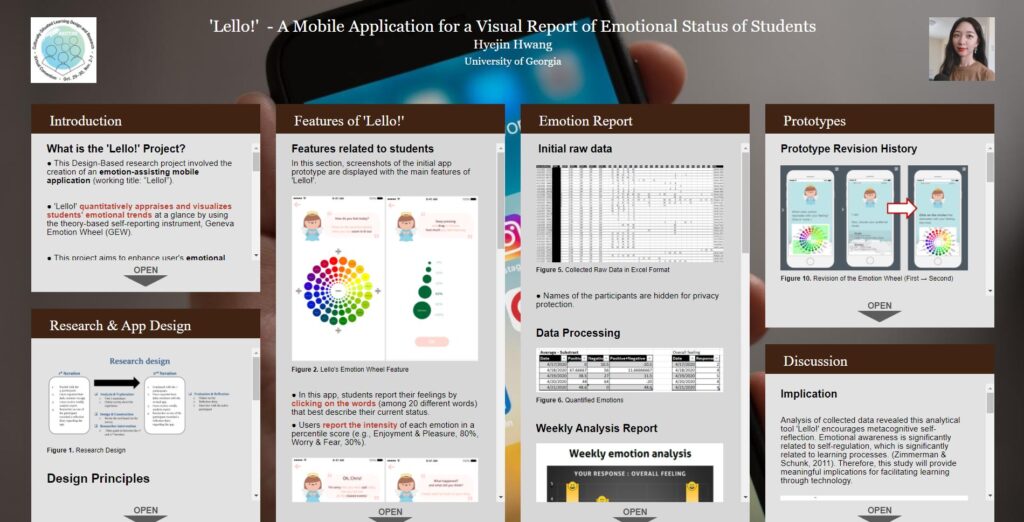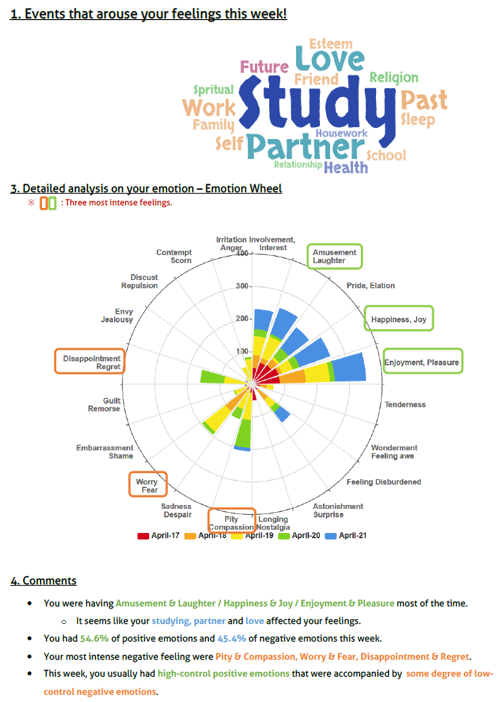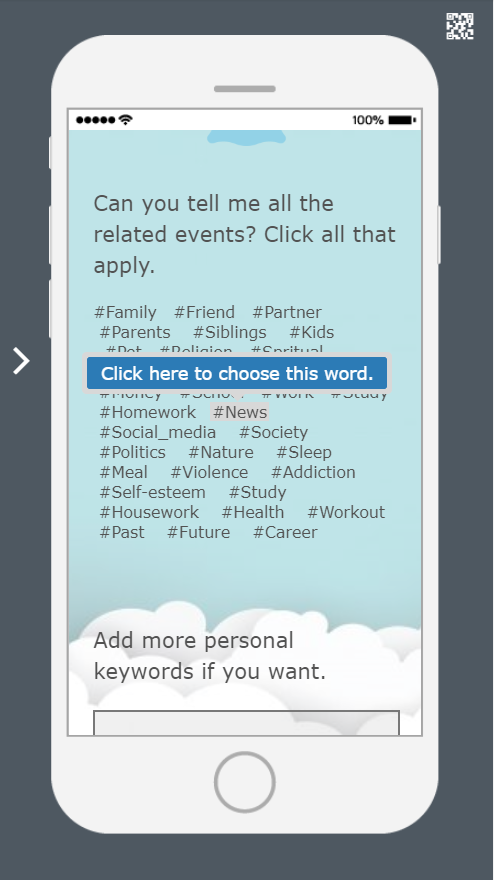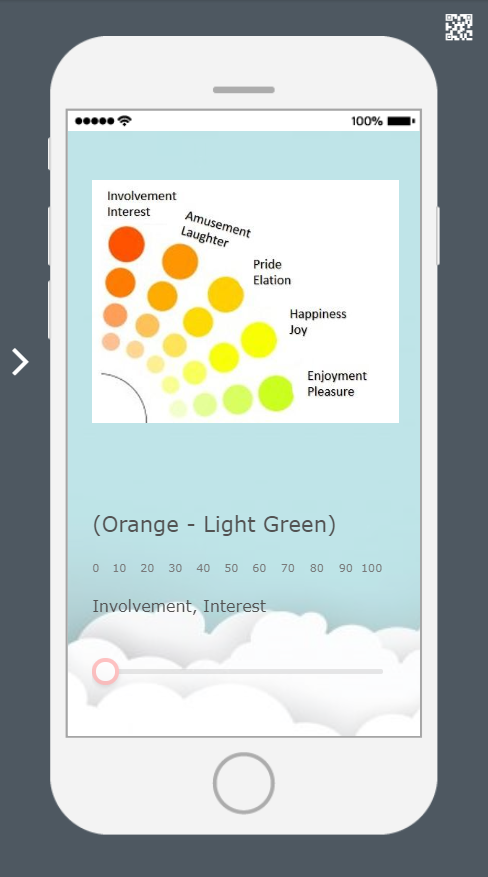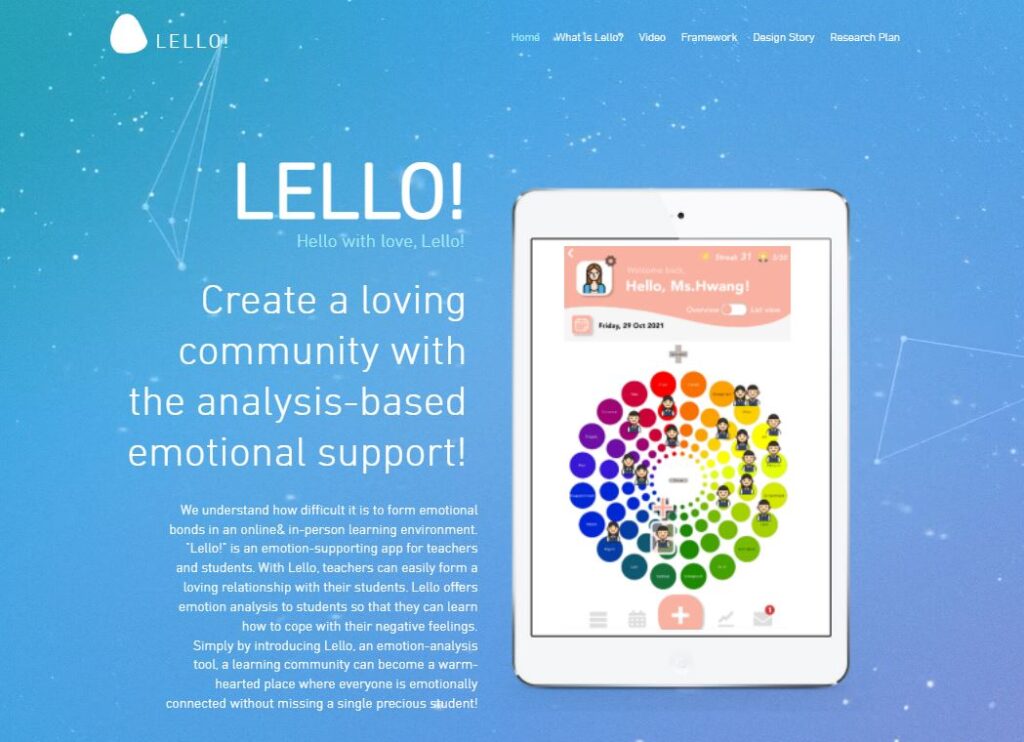Research Idea
Jinny’s current & future research idea
Abstract
My current research focus is on the relationship between a student’s emotional state and their learning. Specifically, I’m interested in the ways in which students’ affective states and awareness of emotions influence their self-regulation, motivation, interactions, and learning processes.
While conducting research on this topic, I hope to implement educational interventions that utilize an instrument (potentially in the form of a mobile application or web-based tool) that quantitatively gauges students’ emotional states and records events that arouse emotions. I would like to examine the effects of using such an emotion analysis tool on students’ emotional awareness, and how this change impacts their motivation, ability to regulate their emotions, and learning experiences. As part of my research, I’d also like to see how teachers’ affective feedback based on student emotion analysis influences the student-teacher relationship and learning outcomes.
Given the current knowledge gap in our LDT field regarding the relationship between emotional factors, student learning, and affective feedback (Arguedas, Daradoumis, & Xhafa, 2016), it is my hope as a researcher that my work will contribute to closing this gap.
Research Questions
1. How does metacognitive self-reflectivity in students’ emotional awareness impact their learning and cognitive processes?
1-a. How does enhanced emotional self-regulation influence students’ motivation and learning while using a self-emotion reporting tool?
1-b. How do students’ capabilities to manage their negative feelings (i.e., emotional self-regulation) change while using a self-emotion reporting tool?
2. How effective and useful is self-report emotion analysis for teachers in understanding students’ feelings?
3. How effective and useful is self-report emotion analysis for teachers in connecting with students?
Background
My area of focus initially stemmed from my teaching experience. I taught about 180 students (mostly 6th grade students) in Korean public schools on a yearly basis. For the purpose of caring for my students, I conducted periodic online surveys, asking about their most pressing concerns both inside and outside of school. Sadly enough, I have observed far too many students suffering from emotional distress as a result of a variety of factors (e.g., family abuse, an intense study load, friendship issues…). In the survey, several students expressed frustration with their inability to fully concentrate or enjoy learning in school due to their negative emotional state. As I became aware of the impact that emotional state can have on individual’s learning experience and well-being, I began to pay attention to this emotional aspect.
Due to the COVID-19 pandemic and subsequent restrictive measures, there has been an increase in calls for managing and dealing with student stress around the world as well. For multiple months, students have been forced to study at home as school activities have been strictly prohibited, and these nationwide lockdowns have impacted more than 91% of the 370 million students around the world (UNESCO 2020). Under these isolation measures, depression and anxiety have been become much more prevalent worldwide (Qiu et al., 2020; Rodrguez-Rey et al., 2020; Wang et al., 2020), with student anxiety and depression levels skyrocketing (Pragholapati, 2020). According to a state-wide survey conducted by the American Psychological Association (2020), 81 percent of teenage students have been negatively impacted by school closures during the pandemic, such as having decreased motivation (52%) and difficulty concentrating on schoolwork (45%).
Theoretical Framework
According to the Hierarchy of Needs theory by Maslow (1943), such mental health issues massively hinder learning because students cannot direct their attention to learning and higher-order thinking until their physiological, safety, and belonging needs are met. Moran’s (2016) meta-analysis also discovered a scholarly consensus that there is a negative correlation between stress and cognitive functioning, given that stress and anxiety impair working memory performance.
Positive emotion of students, on the other hand, is considered as a precursor to learning and a critical factor in facilitating changes in attitude, motivation, creativity, and higher-order thinking skills (Um et al., 2007; Pekrun, 1992). A positive emotional state is also found to be necessary for both the cognitive and motivational aspects of self-regulated learning (Pekrun, 1992). Because emotion is intertwined with student’s cognitive processes (Tyng, Amin, Saad, & Malik, 2017; Immordino-Yang & Damasio, 2007), educators should seek ways to assist students in regulating a negative emotion into a positive one.
Known to enable students to deliberately alter thoughts or goals in order to alleviate negative emotions (Davis et al., 2010), emotional self-regulation can be developed by emotional self-awareness (Goleman et al., 2017). Emotional awareness refers to the ability to perceive, identify, and understand emotions (Boden & Thompson 2015). Being aware of one’s emotions is a necessary precondition for controlling and regulating one’s emotions. Pintrich (2004) linked emotion awareness to learning, arguing that it is one of the self-observation processes that occur during the monitoring phase of self-regulated learning.
As prior research demonstrates, students’ emotional states should be carefully examined and reflected in teaching and learning. Driven by the current educational issues and related theories about student emotion, my Ph.D. research will center on reciprocal causation between emotion and learning. I will be using emotion-analysis instruments to enhance students’ metacognitive emotional self-awareness for the sake of self-regulation and facilitating learning. I would like to investigate how students’ cognitive processes, motivation, engagement with peers and teachers, and learning outcome change under the application of these measures.
Related Works
1. Initial prototype of emotion-analysis instrument (2019-2020)
I developed the initial prototype of emotion-analysis tool during my LDT master’s program at UGA; EDIT6190 (Design and Development Tools) and EDIT8290 (Design-Based Research, DBR) under the guidance of Dr. Kopcha. The poster about the DBR-based pilot study was presented at the Design and Development Showcase of the 2020 AECT International Convention.
2. The second prototype using Qualitrics (2020)
The second prototype was created in Dr. Kopcha’s Design Based Research (DBR) course (EDIT8290). For my DBR project, I’ve created this prototype that enabled me to collect data from the participants of this project. Prototypes were built on the survey platform called Qualtrics for collecting the user’s daily emotion report. Considering the complex and subjective nature of one’s emotion, an overall feeling indicator was initially suggested for recording their feelings with the intuitive graphic, smiley. Then, participants indicated their detailed emotions with the instrument called Geneva Emotion Wheel (Scherer, 2005; Scherer, Fontaine, Sacharin, & Soriano, 2013).
In the emotion report, graphs showing the user’s emotion trend derived from the smiley indicator and the emotion wheel were presented. Also, a wordcloud image was generated from the selected hashtags by the users. The radar graph aimed to help users have a glance at the cumulative value of the emotions they checked.
Please click on each screenshot to view it in full screen mode.
3. The third prototype of emotion-analysis instrument (2021)
The third prototype was designed in Dr. Rieber’s Design Studio course (EDIT8190) during the first semester of my Ph.D. journey. During this third prototype round, I added “edit audience” and “support group” features along with the self-emotion reporting feature.
In this app, students self-report their feelings by selecting the word from a list of 20 that best describes their current situation. Users rate the intensity of each emotion in percentile scores (e.g., Enjoyment & Pleasure – 80%, Worry & Fear – 30%). Students are then asked to choose keywords related to the emotional words they have chosen. The diary menu follows, which allows users to elaborate on their daily events in several sentences more in-depth.
After data is accumulated for some while, visual analysis of the student’s reported emotion is provided on a regular basis. As a form of the Geneva Emotion Wheel (Scherer, 2005; Scherer et al., 2013), a radar graph of cumulative emotion is created, as well as a word cloud image based on hashtags and a short diary. These self-reporting processes and weekly analysis reports are designed to help students visualize and be self-aware of their daily/weekly feelings, which is proven to enhance their emotional resiliency.
This is a prototype version created with Adobe XD, which means it is not yet a functioning app. In the coming iterations, I hope to collaborate with app developers to create and develop the tool for use. Before constructing the working app, I’m also thinking of using the paper-based instrument to capture and collect user emotion data.
To browse the website for this prototype, click the image below. You can also take a look at the demo of the app using this link.
References
American Psychological Association (APA) (2020a). Stress in America 2020, Volume One. APA.ORG/COVID 19.
Arguedas, M., Daradoumis, A., & Xhafa Xhafa, F. (2016). Analyzing how emotion awareness influences students’ motivation, engagement, self-regulation and learning outcome. Educational Technology and Society, 19(2), 87-103.
Boden, M. T., & Thompson, R. J. (2015). Facets of emotional awareness and associations with emotion regulation and depression. Emotion, 15(3), 399.
Davis, E. L., Levine, L. J., Lench, H. C., & Quas, J. A. (2010). Metacognitive emotion regulation: Children’s awareness that changing thoughts and goals can alleviate negative emotions. Emotion, 10(4), 498.
Goleman, D., Davidson, R. J., Boyatzis, R. E., Kohlrieser, G., & Druskat, V. U. (2017). Emotional self-awareness: A primer. More Than Sound LLC.
Immordino‐Yang, M. H., & Damasio, A. (2007). We feel, therefore we learn: The relevance of affective and social neuroscience to education. Mind, Brain, and Education, 1(1), 3-10.
Maslow, A. H. (1943). A theory of human motivation. Psychological Review, 50(4), 370–396.
Moran, T. P. (2016). Anxiety and working memory capacity: A meta-analysis and narrative review. Psychological Bulletin, 142(8), 831.
Pekrun, R. (1992). The impact of emotions on learning and achievement: Towards a theory of cognitive/motivational mediators. Applied Psychology, 41(4), 359-376.
Pintrich, P. R. (2004). A conceptual framework for assessing motivation and self-regulated learning in college students. Educational Psychology Review, 16(4), 385–407. https://doi.org/10.1007/s10648-004-0006-x.
Pragholapati, A. (2020). Covid-19 impact on students. 1–6. Preprints. 10.35542/osf.io/895ed.
Qiu, J., Shen, B., Zhao, M., Wang, Z., Xie, B., & Xu, Y. (2020). A nationwide survey of psychological distress among Chinese people in the COVID-19 epidemic: implications and policy recommendations. General Psychiatry, 33(2).
Rodríguez-Rey, R., Garrido-Hernansaiz, H., & Collado, S. (2020). Psychological impact and associated factors during the initial stage of the coronavirus (COVID-19) pandemic among the general population in Spain. Frontiers in Psychology, 11, 1540.
Sacharin, V., Schlegel K., & Scherer K. R. (2012). Geneva Emotion Wheel Rating Study. Unpublished report.
Sandoval, W. (2014). Conjecture mapping: An approach to systematic educational design research. Journal of the Learning Sciences, 23(1), 18-36.
Scherer, K. R. (2005). What are emotions? And how can they be measured? Social Science Information, 44(4), 693-727.
Scherer, K.R., Shuman, V., Fontaine, J.R.J, & Soriano, C. (2013). The GRID meets the Wheel: Assessing emotional feeling via self-report. In Johnny R.J. Fontaine, Klaus R. Scherer & C. Soriano (Eds.), Components of Emotional Meaning: A sourcebook (pp. 281-298). Oxford: Oxford University Press.
Tyng, C. M., Amin, H. U., Saad, M. N., & Malik, A. S. (2017). The influences of emotion on learning and memory. Frontiers in Psychology, 8, 1454.
Um, E. R., Song, H., & Plass, J. (2007, June). The effect of positive emotions on multimedia learning. In EdMedia+ Innovate Learning (pp. 4176-4185). Association for the Advancement of Computing in Education (AACE).
UNESCO. (2020). New guidelines provide roadmap for safe reopening of schools. https://www.wfpusa.org/news-release/guidelines-roadmap-reopening-schools-pandemic/
Wang, C., Pan, R., Wan, X., Tan, Y., Xu, L., Ho, C. S., & Ho, R. C. (2020). Immediate psychological responses and associated factors during the initial stage of the 2019 coronavirus disease (COVID-19) epidemic among the general population in China. International Journal of Environmental Research and Public Health, 17(5), 1729.
